Motivation Design That Works
Taking Motivation from Theory to Practice
Hi there, I’m Robert and welcome to my behavioral insights page. You will find posts about behavior, psychology and decision making to help grow products, innovate services and improve employee experiences.
How should we approach design that increases engagement?
When we are thinking about motivating our customers or employees, we rarely approach it from an evidence base.
One of the things that is important to understand when it comes to motivation is the quality of that motivation - as not all motivation is created equal.
We normally ignore this insight, as we assume everyone is motivated in the same way - or worse, we assume we can motivate anyone to change.
To help us understand motivation, let’s define a bit more one theory I like to use called self determination theory.
What is Self Determination Theory?
According to the Center for Self Determination Theory “ SDT is an evidence-based theory of human motivation, personality development, and wellness.
SDT articulates a meta-theory for framing motivational studies, a formal theory that defines intrinsic and varied extrinsic sources of motivation, and a description of the respective roles of intrinsic and types of extrinsic motivation in cognitive and social development and in individual differences.”
Let’s define the motivation types:
Intrinsic motivation: This type of motivation is stronger and more autonomous. This means that we do the activity simply because we find it enjoyable.
Extrinsic motivation is a type of motivation that is weaker and more controlled. This means we do the activity for some kind of external reward.
Within Self Determination we have the Self Determination Theory Motivation Continuum by Deci and Ryan - which can then help us understand where our customers or employees motivation places in a given context.
The more to the left, meaning the more extrinsic - the harder it is going to be for us and them to change any behavior.
So now that you know the types of motivation, which one should you be designing for first?
1) The intrinsic one?
2) The extrinsic one?
Working on enabling behavior can have better results if we start with the groups that are more intrinsically motivated first - meaning start with the ones on the right side first.
These groups tend to be early adopters, open to trying things and internally wanting your experience to do the right job for them and eventually for the people around them.
Start with this group to learn what works and what needs to change in your offering. You will need to think of a few motivation design techniques and translate those into actual designs. (i’ll show you a few below)
Once you find what works well, then you can move to other groups of people, those who are still on the intrinsically motivated continuum but need a bit more social proof to move forward with the behavior.
Once you have both your early adopters and social proof converts, then these groups together can help bring over the less motivated people, as that group may now see your offering as the norm.
In my experience, lots of teams build their offerings and features ignoring intrinsic motivation.
If we have a look at most apps, employee engagement programs and even loyalty programs, they are designed to give rewards - the features are focused on extrinsic motivation - which means that once the rewards are taken away, so too can the motivation end.
With a motivation theory like self determination you can learn to apply the right designs to enable for intrinsic motivation.
Those designs should be informed by three basic psychological needs:
-Autonomy: I make my own choices, I am in control
A design feature could be done by exploring the behavior as well as the preferences and dislikes as we see in our aimforbehavior.com example below.
-Competence: I am learning, progressing, improving, and getting better
A design feature here could include something like this “Journey Feature” in the image. The main function according to the authors is to “increase the sense of competence and self-efficacy by showing visible cues of progress and listing all the actions taken on the way to an active life. The changing landscape may motivate users to complete actions to progress into new levels.”
-Relatedness: Community and social aspects; being part of something bigger
Here you could think about adding reflective statements in your messaging where you can acknowledge feelings and experiences.
In the end, if we are able to understand how to create experiences that motivate beyond rewards and extrinsic motivation, we will have a better chance of increasing engagement and overall success.
Book Suggestion: Engaged by Amy Bucher
This book by Amy Bucher is a real find and will help you understand even more how to design for motivation and engagement. Amy is Vice President of Behavioral Design at Lirio, where she leads a team of behavioral scientists and health experts focused on designing AI-powered behavior change journeys to drive better personal and population health.
I am a big fan of Amy’s work and grateful for the advice she has given me when I’ve had design questions. Amy covers psychology, discussing topics such as motivation, emotions, and social influence, and how they can be used to create engaging experiences.
Throughout the book, she provides real-world examples from Fitbit, to Weight Watchers. She also includes examples of how she uses COM-B and the Behavior Change Wheel in her work.
Overall, "Engaged” is a useful resource for designers, product managers, and anyone interested in creating products and experiences.
You can also find more of Amy’s work here:
Amy’s Book: https://rosenfeldmedia.com/books/engaged-designing-for-behavior-change/
Amy’s Website: https://www.amybucherphd.com/
Have you tried to design for motivation? Please let me know in the comments or email me with your thoughts hi[@]aimforbehavior.com
Thanks for reading,
Robert
If you are curious about my behavior design course:
https://courses.aimforbehavior.com/behavior-design
If you want to work with us on a challenge: https://www.aimforbehavior.com/consulting-in-behavior-science









